Late fall and winter can be a tough time for foragers in the majority of North America. After the fall mushrooms are gone, there isn’t a whole lot left in the realm of wild food. The one thing that most of us have, no matter where we live, is pine or other conifer needles. They are something we see nearly every day, but did you know that they are edible and medicinal? Foraging for pine needles is one of those things that you can do in the winter time to connect you to nature and the wonderful living world around you.
Wildcrafting Weeds
If you want to learn more about the edible and medicinal weeds that surround us and how to use them, check out my eBook: Wildcrafting Weeds: 20 Easy to Forage Edible and Medicinal Plants (that might be growing in your backyard)!
Gather & Root Online Foraging Course
My online foraging course is a great way to learn about wild edible and medicinal plants! Sign up to learn more about the gather + root online foraging course here.
Foraging for Pine Needles
One of the best plants you can utilize in late fall and winter are trees, specifically conifers. Conifers are evergreens, meaning that they don’t lose their needle like leaves in winter.
The conifer division is called Pinophyta, which has eight families including Pinaceae and Cupressaceae.
These two families contain the majority of what we think of as “pine trees” in the United States, including firs, spruces, hemlocks, cedars, pines, junipers, and redwoods.
There are many different species of conifers that are edible and medicinal, but please consult a guide book to make sure you are foraging for the right tree as there are a few that are toxic, most notably those in the Yew family.
I also have a complete guide on how to identify different conifer trees.
Here are a few of the common conifer trees to forage on the west coast of North America.
Douglas Fir
This is the quintessential Oregon tree, and the variety that we always had as a Christmas tree growing up. Smelling a Doug Fir always puts me in the holiday spirit!
The Douglas Fir (Pseudotsuga menziesii) is in the Pinaceae family, and is actually not a Fir at all.
It was a difficult tree to classify, and so it was finally placed in it’s own genus, Pseudotsuga, which means “false hemlock.”
The tips of Doug Fir branches are the newest growth and are usually a lighter color of green. They are tender and edible, and can be made into a tea that is rich in vitamin C.
An infusion of the needles may also be beneficial as a healing wash for arthritis. Or you can always make these amazing sounding Douglas Fir shortbread cookies!
Ponderosa Pine
The Ponderosa Pine (Pinus ponderosa) is also in the Pinaceae family.
There has been some concern that Ponderosa pine is toxic and can cause abortion when used internally, but that could also a myth (read: Foraging Myth Busting by Eat the Weeds).
Regardless, I would probably steer clear of using ponderosa pine internally if you are pregnant.
But for everyone else, consuming ponderosa pine in small amounts shouldn’t be a problem. Indigenous Americans have been doing it for thousands of years!
Pines have long needles that are bunched in different numbers depending on the species, which helps with identification.
Ponderosa usually has three needles per bunch, sometimes two.
Pine tree species, such as Ponderosa, Lodgepole, Jeffery, Western and Eastern White, and Sugar Pine, have all long been used medicinally.
Pine needles are generally used in a tea that can be used internally for respiratory ailments, or externally for a multitude of skin conditions.
They are also high in vitamins C and A, as well as many minerals and antioxidents.
Use foraged pine needles to make pine needle cough syrup during the fall and winter!
Blue Spruce
Can I tell you how much I love Spruce trees? Especially the Blue Spruce (Picea pungens, also in Pinaceae), with its beautiful silvery blue-green color and sharp, spiny needles.
You know it’s a spruce tree if it hurts when you grab them!
Spruce trees are another common Christmas tree, a gorgeous one at that.
They are actually native to the Rocky Mountains, but have been introduced well beyond their native range and are common in parks and public areas in much of the nation.
An infusion of spruce needles makes a lemony tasting beverage that is used to treat colds and settle upset stomach, and is also very high in vitamin C.
Pregnant women should avoid drinking spruce tea.
You can also use spruce tips in the spring time to make a delicious spruce beer!
Coastal Redwood
The Coastal Redwood (Sequoia sempervirens) is the only one I will be talking about today that is in the Cupressaceae family.
These huge and long lived trees grow along the Northern California and Southern Oregon coast. We are lucky enough to have them growing locally!
To me the leaves and needles have a bit of a prehistoric look about them.
They are long and flat, green on the the top and silvery white underneath. The end of each leaf has a little bud that will eventually turn into a cone.
Redwood needles have similar properties as the others I have listed: high in vitamin C and good as a tea for colds and flus. It is also antimicrobial and and stimulates circulation.
Beyond that, it feels as though you are drinking a piece of history!
Here’s my recipe for Conifer Needle Shortbread Cookies where I use redwood needles. It’s a favorite for the holiday season!
Uses for Conifer Needles
There are many edible and medicinal uses for foraged pine and other conifer needles!
For a complete guide, see my post on 30+ Conifer Needle Recipes.
Pine Needle Tea
As you may have gathered, the most common way to use these conifer needles medicinally is to make a “pine needle tea” out of them.
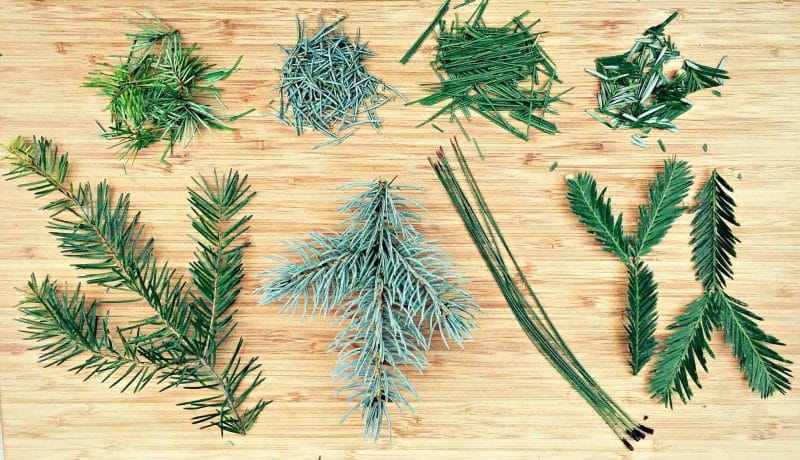
Douglas Fir, Blue Spruce, Ponderosa Pine, Coastal Redwood
First you will want to strip or snip the needles off the branch, and if they are really long (like many pines are), cut them in to smaller pieces.
Add a spoonful of needles to a mug, pour boiling water over them, and let steep. This will smell like a warm mug of the holiday season!
Sip on the wonderful piney taste and get a good dose of immune boosting vitamin C. This tea was traditionally consumed throughout the winter to keep scurvy away.
Find more details on how to make pine needle tea here: Conifer Needle Tea with Pine, Fir, or Spruce
More Conifer Needle Recipes
Here are some great ways to use your foraged pine and other conifer needles!
- Fir Needle Forest Chai
- Conifer Infused Vodka
- Winter Infused Gin
- Rosemary Pine Beard Balm
- Winter Spice Pine Soap
There are many other great ideas for using pine needles in this post I wrote for the Herbal Academy: 8 Terrific Ways to Use Pine Needles Right Now.
Most of these trees are very easy to find and identify (use a guide book, like these Western Region and Eastern Region Field Guides to North American Trees), and are quite widespread.
I actually found three of them right in my yard, and the other one (Blue Spruce) not far down the road.
You may even be able to make a tea from your own Christmas tree, as long as you have a real tree that is. Just be sure that it wasn’t sprayed with chemicals first.
For more about foraging in winter, check out my post about it here:
Hope you have a happy fall and winter season, and drink lots of pine needle tea!


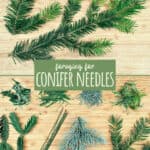


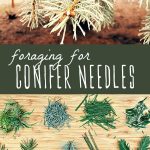
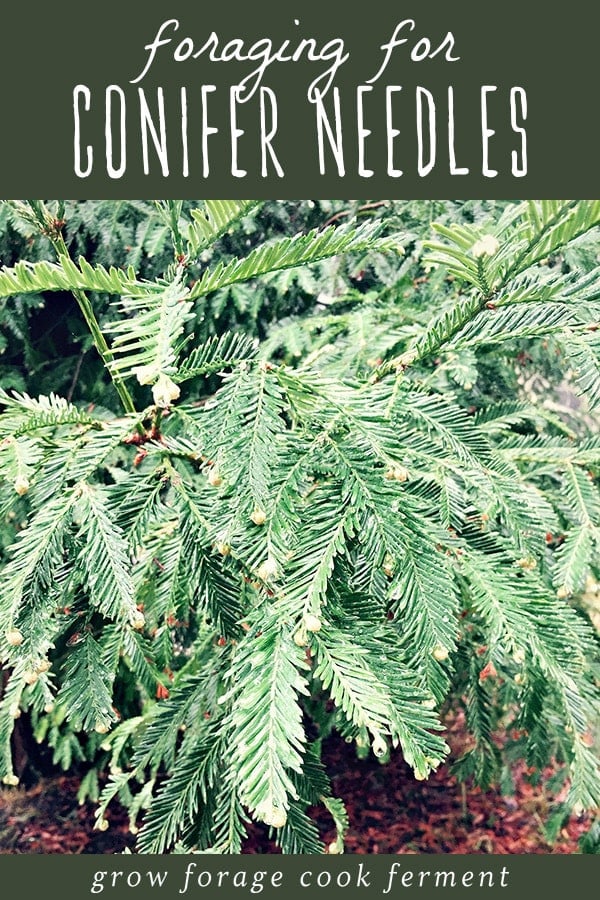



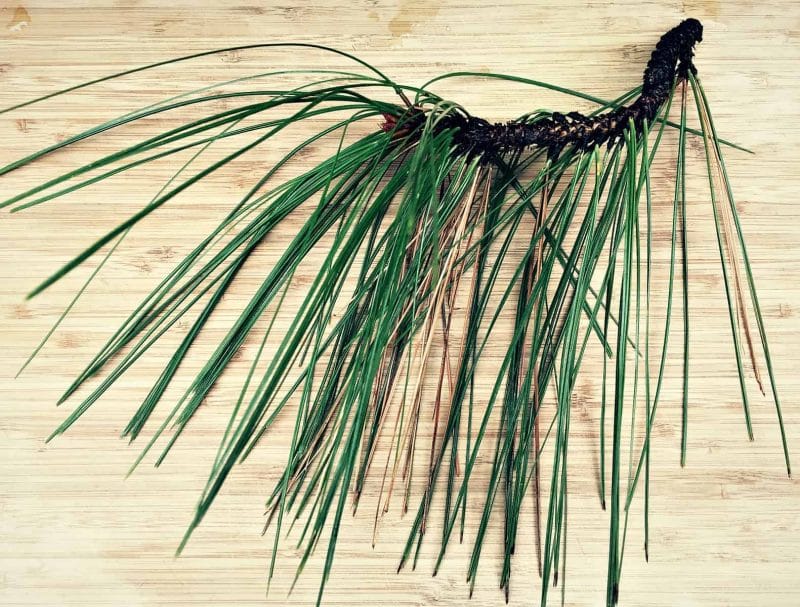
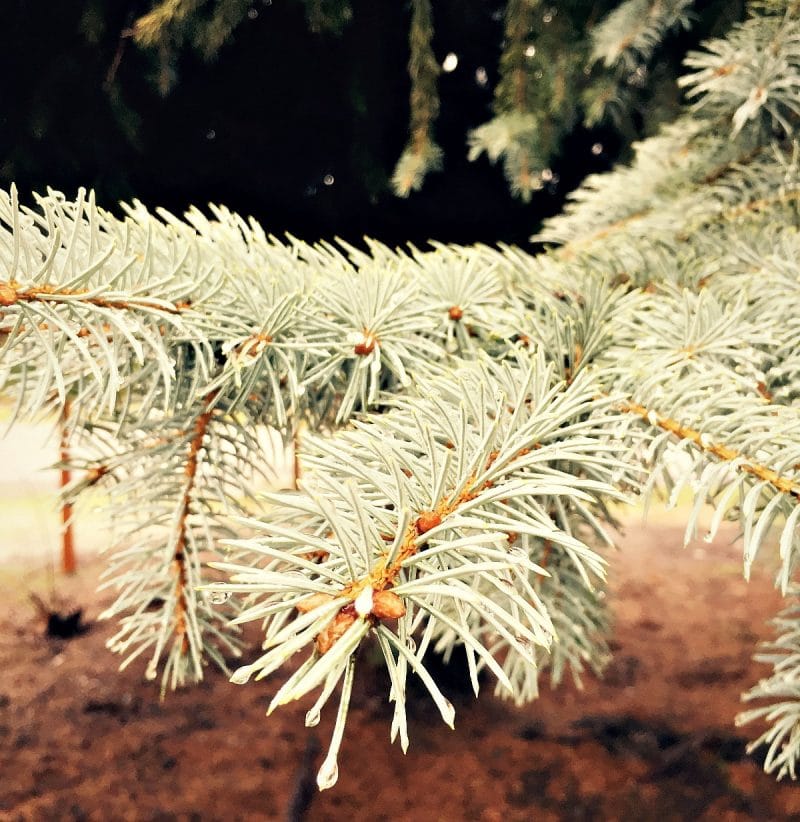

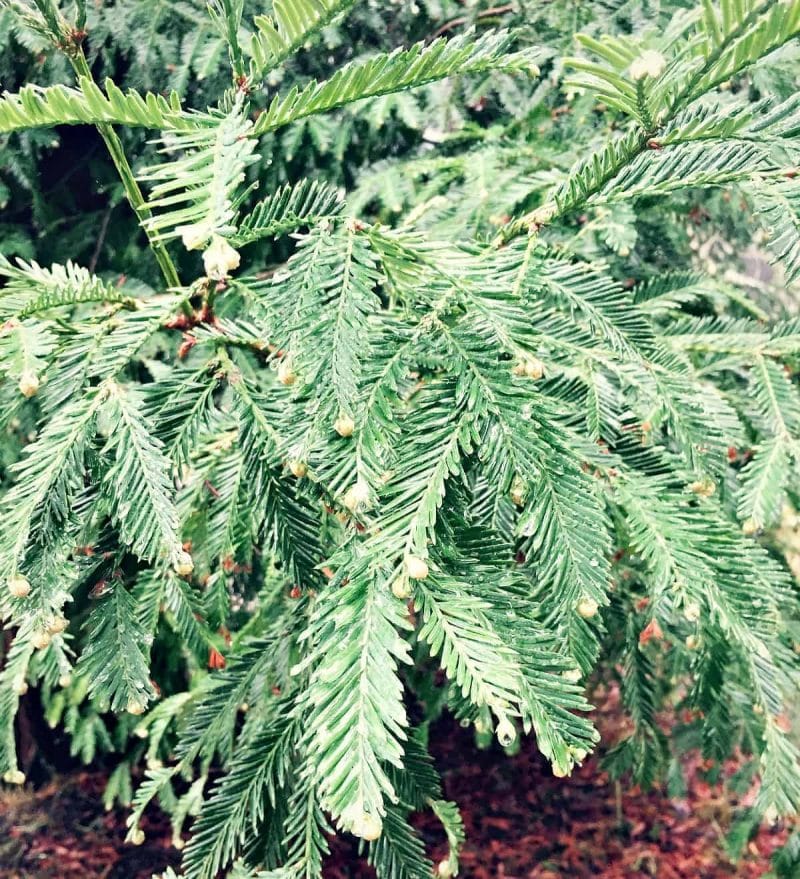

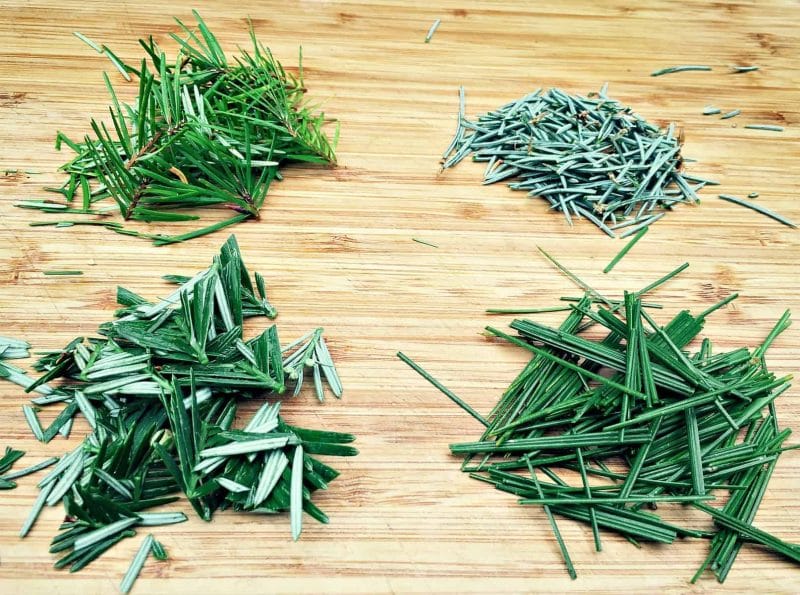
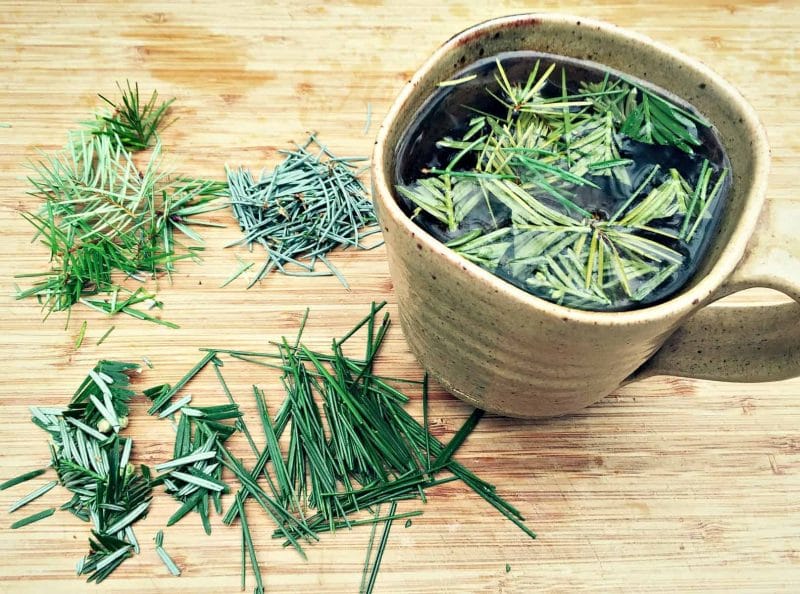

We live in north east Pennsylvania is our hemlock tree needles usable for making tea I heard hemlock was deadly poison, Just wondering
Water hemlock and poison hemlock are both poisonous herbaceous plants (not trees). They look entirely different from eastern hemlock, which is an edible conifer tree. Read more about poison hemlock here.
What about cupressus macrocarpa? Can I use that to make tea?
Cypress needles aren’t toxic to humans, but they don’t taste good, so I would stick to pines, firs, and spruce for tea.
Is it ok to freeze the pine needles? I notice they become dry and brown if kept stored too long in a jar. I only have access to foraging them once or twice a year so keep some in the fridge in glass containers and other quantities in the freezer. Is this ok?
Thank you so much!
That’s totally fine, Kelly!
Thank you for your great article…..you are quite sure that ponderosa pine is ok for using the needles for tea.?Do any other types of pines have three needles per set? Is the doudglas fir a type of pine and is it ok for tea and do the needles contain SURAMIN? I have read this . Thank you kindly
All pine trees are edible, so yes you can use doug fir needles for tea. The only conifer tree that is not edible is the yew tree.
Hi I live in Victoria, Australia, do you have any idea which pine varieties here would be good for a tea or if there is any toxic pines? I just can’t seem to find the information anywhere. Many thanks, Willow
Hi, Willow! I’m sorry, I’m unfamiliar with Austrailia. Are there any good foraging books for your area?
Interesting article, thank you! What about the Mason Pine? Thank you!
I’m unfamiliar with mason pine, but most pine trees are edible.
The Massoniana Pinus (Masson Pine) is high in Suramin and Shikimic acid and is safe to consume, no studies have been conducted on Pregnant women so I would advise to avoid.
Is there a way to keep pine needles to be used in the future…i.e. can they be frozen, dried. If so I would love your opinion on how to do it. Thanks so much.Margo
Yes, you can set them out to dry for a few days.
I live in the mountains of East Tennessee . There are large amounts of wild rapid growing pine trees. We always called to them southern yellow pine, hickory pine. scrub pine. They grow very tall and the needles are in groups of 2 and are short. The cones are small. Just wondering if these pine needles are safe for tea. I don’t see the white pines with 5 needles per group which most people use for tea.
Hi Sharon. It’s really hard for me to say since I’m unfamiliar with what grows in your area. If it is indeed a pine, it should be edible. Only yew trees are toxic and should be avoided. However, you may want to get a good tree identification book to be sure of what kind of trees you have.
What is the best way to store the pine needles, that will last longer than one week? Can they be refrigerated? Cool dark bin? Would love ideas/suggestions.
You can set them out to dry for a few days with great results and then store them in a mason jar or similar.
I know it is not common American coniffer but would you know if Picea Omorika is good for syrup or any consumption?
Tnak you
Hi, Jelena. Unfortunately, I have not tried that species, but spruce is edible, so you could try making syrup with it. Let me know how it turns out!
Is Mugo pine a good tea option? Also, I’m breastfeeding a one year old- what is your opinion on drinking pine needles while nursing?
I have never used mugo pine, so it’s hard to say if it’s a good option for tea. Pine needle tea should not be consumed if you’re nursing.
Where can I buy pine needles for this tea? I don’t have access to this tree and would be great if I can order it from a company that doesn’t use pesticides.
http://www.herbni.com/eng/100-natural-pine-needle-powder.html
You can buy beyond organic bio-activated Pine needle powder tea here.
Just finished a cup of it, very nice.
Three varieties, Fir, spruce and pine.
here
I really like this idea with spearmint and lemon since I recently have been very ill with
mold ingestion and have been frantic to find help for my throat and swollen neck glands.
I have a pine tree and both mint and spearmint in my yard so will let you know how this “tea” relieves the soreness. Thank you so very much.
Thank you for all the wonderful information! I am relatively new to foraging but I have some needles that I dried planning to use in tea.
Wonderful information! I included this page in a roundup of great information on foraging pine for the January issue of Wild Kids magazine (a free printable nature study magazine for kids and their grown ups). :)
Just wondering if you know the shelf life of the needles. Do they more or less have to be used fresh, or could you have some on hand, stored?
They are best when used fresh. They will last for up to a week in storage, but after that they start to turn brown and lose some of their potency.
Thank you for your information!
Do you know if there’s a better time of year to forage pine needles for tea? Does the season make any difference in its potency?
Should you avoid collecting the needles for tea when the tree is producing pollen?
Thank you
A pine was just cut down in the neighbour’ s yard. It’s covered with tiny cones… an inch or less. Is there anything worth picking/saving them for?
Thank you for all the wonderful information! I am relatively new to foraging but I have some needles that I dried planning to use in something can those be used in tea?
Most conifer needles are edible and can be made into a tea. Just make sure that they aren’t from the Yew tree, which is toxic.
Thanks for this post! Just wanted to share that spruce beer is a kind of soda pop from Quebec, Canada. I live on the west coast, too (hi there, neighbour!) in British Columbia and have seen spruce beer make its way out west in the past 10 years or so, with the rise in popularity of poutine, another classic Quebecois food – fries with cheese curds and gravy! Anyhow, I’m thinking that if you can’t find spruce beer, maybe you could make your own by taking this pine needle infusion an extra step by making a simple syrup with it, then adding it to some club soda or sparkling water. I think I might give that a try myself! :)
Great Idea!
Im trying to figure out what kind of pine tree I grabbed needles from and it looks like its a Ponderosa pine possibly.. Needles are in sets of 3. Very long.. I watched a video that said it was highly toxic.. Whats the best way to determine if the needles someone has are safe?
They might be Ponderosa, the best way to identify Ponderosa is by is puzzle piece looking bark. Regardless, Ponderosa isn’t toxic unless eaten in crazy large quantities (like literal tons), and should be avoided while pregnant.
Depending on where you live your Christmas tree could and most likely is a very bad idea to make tea from as most commercially sold Christmas trees are sprayed with a green dye and a fire retardant. Just a FYI.
And not to mention pesticides and herbicides. But there are organic Xmas tree farms that don’t do these type of practices, just do your research first!
::::::Looks longingly at his christmas tree::::::
From what I understand it’s also high in Vitamin C.
Does this include pinus radiata in New Zealand?
Packed with good information. A little honey and I an set for a great cup of tea
Ha! I just finished reading a book about a couple who were stranded on a mountain and one of the things they did to survive was drink pine needle tea! I must be meant to try it.
This is my favorite winter tea. Great post!
I like to add spearmint, honey, and lemon to my pine needle tea. Wonderful for sore throats and congestion.
Western Hemlock too. Nice and lemony flavor. Not poisonous.
Who would have thought…tea from pine trees! I will try this….
The sap has so many calories and nutrients that Indians have been using it for hundreds of years for survival food. You can also make a syrup out of the sap for cooking and baking. Thanks for sharing this; I also shared this on my Facebook and recommended your web site…. lots of goodies to learn… Have a wonderful and safe Holiday Season… Thanks again..